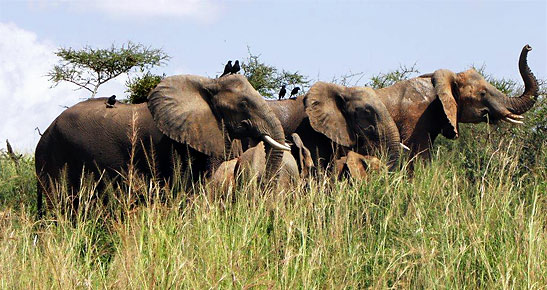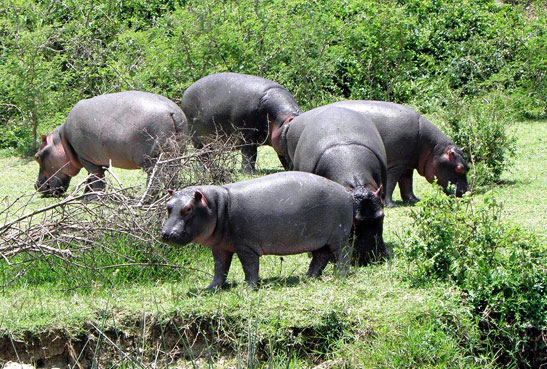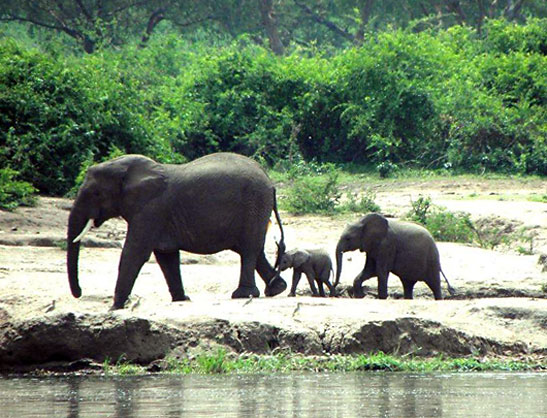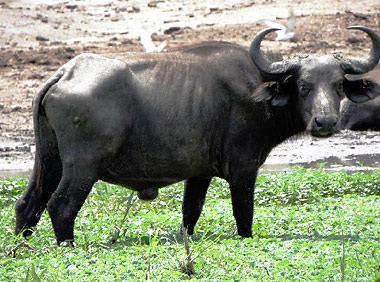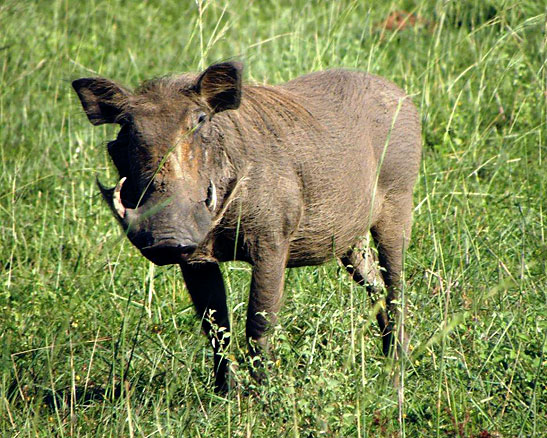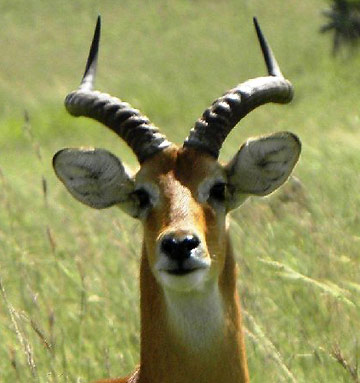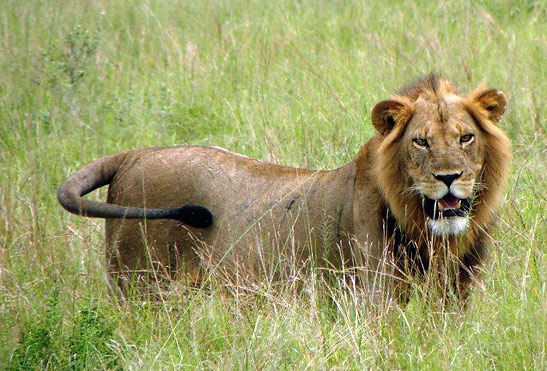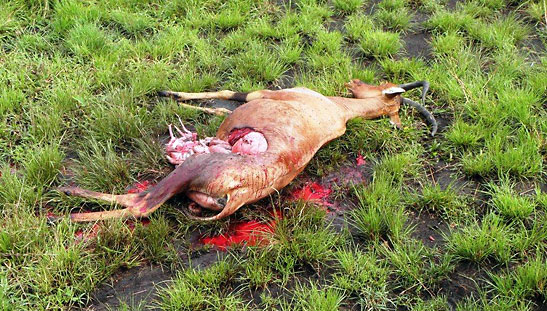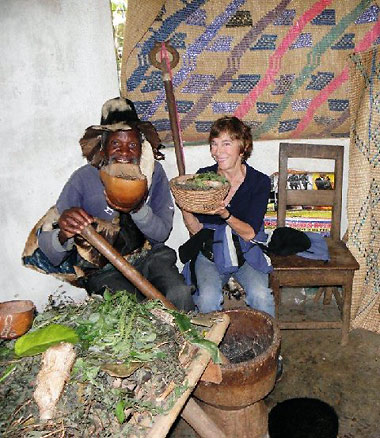 |
 |
|
 |

|
Uganda Safari:
Among the Best No Matter How Much They Try to Talk You Out of It! Story by Fyllis Hockman Photographs by Victor Block
And so began our first game drive in Murchison Falls National Park in southeastern Uganda as part of an ElderTreks Tour, which promotes "Small Group Exotic Adventures for Travelers 50 and Over." Immediately as we entered the park, a handsome water buck sprinted across the road followed by an assortment of other antelopes and a number of elephants standing around oblivious to the clicking of cameras around them. Shortly thereafter, we were immersed in baboons, cape buffalo, giraffes, warthogs and the occasional hyena.
I don't know if the lowering of expectations was intentional but its effect was to electrify everyone in the van who oohed and ahhed at the sheer numbers of animals we encountered and led to the exclamation of one experienced safari-goer to declare, "This is the best safari ever." Enhancing the trip even more was the lack of multiple vehicles taking up prime real estate in which to view the animals. Twenty vehicles a day versus the dozens found in Kenya and Tanzania, though our guide, Hamm, predicted that eventually Uganda would catch up. "Well, it's kind of nice to be a pioneer," observed Nancy Burnett from Seattle, WA. And unlike other safaris I've been on, in Uganda the game drives are by land and water. On one along the Nile River in Murchison Falls, our guide proudly announced that there were 450 different species of birds but after he pointed out the first few, I couldn't help but think, "Oh god, we still have 446 to go." I'm obviously not a birder. However, of the animals he mentioned we might see – baboons, hippos, elephants, crocodiles and buffaloes – we saw them all. And that included, to the extreme joy of everyone on board, the elusive shoebill, of which only 8 pairs exist in the park, who preened and posed at great length for the cameras. We took a short walk off the boat onto savannah grasslands where we sprinted between numerous piles of assorted dung and footprints, which were alternately identified as coming from hippos, elephants, lions and water bucks. No actual animal sightings but I did sense they were all lurking nearby. Still pretty heady stuff. On a second boat trip along a different part of the Nile, we saw more land animals than on the first river trip and better even than some safaris: baboons, hippos, elephants, crocodiles, warthogs, cape buffalo and antelopes all by the water's edge.
Initially, I could only see only the tiny ears of the hippos peeking above the water until a big splash announced the arrival of another 6000 pounds into view. You don't want to mess with a hippo! And I've seen crocodiles in the past but usually had to rely upon a guide to identify the snout sticking out of the water. Not here. We saw multiple full-length crocs soaking up the sun on shore and staying around long enough for photos before slithering away into the river. These were very obliging animals. The Kazinga Channel Cruise in Mweya brought us into contact with the highest population of hippos in Uganda, plus of course their standard neighbors: more buffaloes, elephants, crocs and the de rigueur abundance of birds. We were all gaping at a particular family of elephants -- or Ellies as they are more affectionately called -- with a baby of mere months so small you could practically take him home and put him on a display shelf.
Oblivious to this unusual occurrence, the one birder in the group was staring in the other direction, waxing enthusiastically about the black-winged stilt in his sight. When teased about not even seeing the ellies, he deadpanned: "If elephants could fly, then I'd notice them." Such is life with a birder… But by the end of the trip, even I could recognize a common black and white kingfisher! Right in front of the elephants were the barely submerged tips of hippo ears and I cringed at the thought of what one elephant misstep might do to them until I remembered the multi-ton enormity of the animal attached to them. I suspect the ellies purposely step gingerly.
Back on land in Queen Elizabeth National Park, cape buffalo were happily wallowing in mud which acts as both sun protection and insect repellant. Considered one of the most aggressive and feared of the African mammals, I figured that maybe it was compensating for its very ugly demeanor. The warthog, however, another resident not known for its good looks, clearly does not have the same compensatory good fortune. I figure it's just too ugly for any animal to even want to eat.
We also saw staggering numbers of antelopes, literally thousands of them of all sizes and shapes, each type with its distinctive, lovely shaped and colored horns from curved to straight, twisted to rippled, rounded to wavy. The list goes on as far as the antelope can run. Plus hundreds of giraffes and elephants and a multitude of all the other usual suspects. Still the greedy passengers in the van continued to clamor for lions – or at least one leopard in a tree. By this time we had become so jaded, it was "Oh don't bother getting up, it's just another dozen elephants." We did spend a lot of time on several drives scouting the terrain in furtive attempts to spot the big cats. Hamm, our guide, was feeling increasingly frustrated, protesting that over 90% of the time, lions are seen. At one point a line of cob antelope standing in quiet attention all looking to the right alerted us to the possible presence of our desired prey – good for us; bad for the cobs. After a while, the cobs reverted back to grazing dashing our hopes in the process: good for the cobs; bad for us. Eventually, we did track the small family of three cats to a large cluster of bushes from which a flicker of face or twitch of tail emerged, but the rest of their bodies eluded us. As if worried we were getting too close, papa lion suddenly ran out from the bush to divert our attention. There he stood, a short distance away, very elegant and stately and full of pride, so to speak, mesmerizing every inhabitant of the van – with the possible exception of the birder. When we pulled away, he sauntered at a leisurely pace back into the bush, confident his family was no longer in danger. Hamm breathed a very audible sigh of relief.
The next day, it was a fresh kill nearby that caught our attention. Bright red blood still flowed from the poor dead Topi as did much of his intestines. But the exact nature of the alleged predator confounded our guide: Not the lions, they would have finished off the meat; the topi was too big for a leopard to have brought him down. Footprints near the kill suggested the culprit might be an hyena but Hamm insisted he would still be there feasting. As we drove away, Hamm kept shaking his head as he further pondered the mystery. Later that afternoon, we returned to the site of the kill only to find it had been pulled into a bush from which the devoured head and leg were still visible. Only a leopard would have done that, Hamm concluded. Mystery solved!
Observed Jon Perica, an environmentalist from Northridge, CA: "The ElderTreks Uganda trip offers the most diverse scenery and wildlife than any other country in Africa." And for those still seeking more animal sightings to add to their list, a trip to Lake Mburo National Park adds zebras, elands and the ever-graceful impalas to the count. Gorilla-trekking and chimp-tracking were another awesome part of the tour but are separate stories in their own right.
And it wasn't all animals all the time. We also visited a small tribal village that was a US Agency for International Development model of conservation, environmental and wildlife protection, and hygienic efforts successfully implemented in the most primitive of settings. An incredibly impressive accomplishment! Plus other cultural exposures including a traditional medicine man, a modern hospital, a local school and a meeting with members of an ancient Pygmy tribe. For more information, visit eldertreks.com. Caveats Don't even think about coming on this trip if you have any kind of neck or back injury. There is barely a moment spent in the van in which you are not literally bouncing up and down and lurching side to side. Outside of our accommodations, Western toilets are rarely available; squatting in the bush or over a hole is a useful skill to develop. If you're overly attached to electricity, whether for light or a hair dryer, you might reconsider the trip. Bring a book light for reading at night and leave your vanity at home. Showers were available at all the lodges, just not necessarily in the manner to which you are accustomed. Except for maybe caveat #1, none of these should deter you from the trip; just make you better prepared for it. Related Articles: (Posted 3-7-2013) |
|
This site is designed and maintained by WYNK Marketing. Send all technical issues to: support@wynkmarketing.com

|






